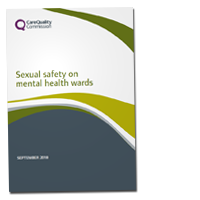This report shares our findings and recommendations after reviewing incidents related to sexual safety on mental health wards.

In 2017, following concerns raised on an inspection of a mental health trust, we carried out a review of reports on patient safety incidents that staff had submitted through the NHS National Reporting and Learning System. We found that many reports described sexual safety incidents, including sexual assault and harassment.
We decided to look at how often other mental health trusts in England report sexual incidents. We spoke with providers, people who use services and voluntary and charity sector stakeholders and found that sexual safety is still a major issue in mental health services.
What we did
We started by analysing reports of incidents that took place on wards between April and June 2017. We used a ‘text-mining’ approach to identify which of these reports may be about sexual incidents. We then carried out a more in-depth analysis of those reports that described sexual incidents involving patients, staff, visitors and others.
We held 4 events to share findings from our analysis. We used these events to help us better understand the effect of such incidents on patients and staff, the factors that influence sexual safety on mental health wards and what might be done, locally and nationally, to improve the situation.
These events were attended by:
- 106 healthcare professionals who represented 49 NHS trusts and independent sector providers
- 14 people who work for an arms-length body
- 16 people who have used mental health services or who work for organisations that directly support people who have used mental health services
In addition, a small number of people asked to speak to us individually to share their experiences or those of people they care for.
We also carried out a review of previous work in this area.
What we found
Our analysis of nearly 60,000 reports found 1,120 sexual incidents involving patients, staff, visitors and others described in 919 reports – some of which included multiple incidents. More than a third of the incidents (457) could be categorised as sexual assault or sexual harassment of patients or staff.
Providers and people who use services told us:
- People who use mental health inpatient services do not always feel that staff keep them safe from unwanted sexual behaviour
- Clinical leaders of mental health services do not always know what is good practice in promoting the sexual safety of people using the service and of their staff
- Many staff do not have the skills to promote sexual safety or to respond appropriately to incidents
- The ward environment does not always promote the sexual safety of people using the service
- Staff may under-report incidents and reports may not reflect the true impact on the person who is affected
- Joint-working with other agencies such as the police does not always work well in practice
Next steps
People need to be kept safe and their privacy and dignity should be maintained at a time that, for many, is the most vulnerable point in their lives.
We will be working with system partners, including providers,commissioners and improvement organisations to work together and take the following actions to improve the sexual safety of people who use services:
- The health and social care system must provide co-produced guidance to enable everyone who delivers mental health services to do the right thing about sexual safety.
- Staff should be given the right training to enable them to put in place new national guidance for managing sexual safety incidents. Leaders must also encourage staff to have open conversations about sexual safety with people who use services.
- Providers, stakeholders, staff, people who use services, the police and safeguarding teams should work together on the approach to sexual safety incidents to make sure that disclosures are taken seriously and given the attention and sensitivity they deserve.
Download
Sexual safety on mental health wards: Summary
Sexual safety on mental health wards
Sexual safety on mental health wards: Easy to read
Join the conversation
Follow #SexualSafetyMH on Twitter
Related information
Press release: CQC calls for new national guidance to improve sexual safety on mental health wards